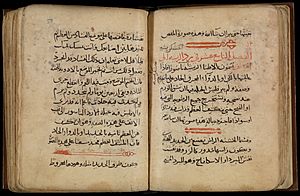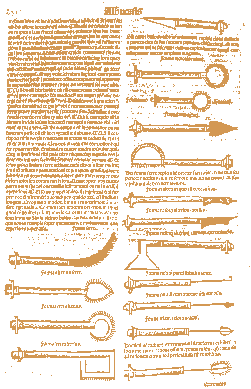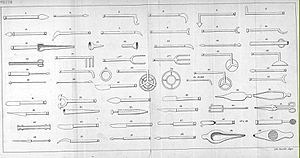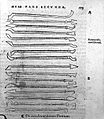- This page was last modified on 20 June 2025, at 18:27. Suggest an edit.
al-Zahrawi facts for kids
|
Abu al-Qasim al-Zahrawi al-Ansari
|
|
|---|---|
| أبو القاسم خلف بن العباس الزهراوي | |
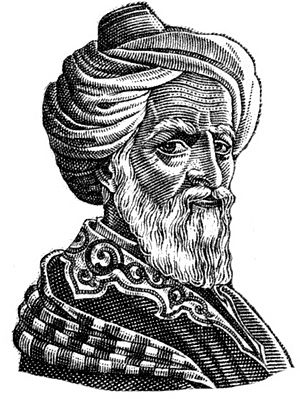 |
|
| Born | 936 CE |
| Died | 1013 (aged 76–77) |
| Occupation |
|
| Era | The Islamic Golden Age |
| Known for | Founder of medieval surgical and medical instruments, writing Kitab al-Tasrif |
| Scientific career | |
| Influenced | Abu Muhammad bin Hazm, Guy de Chauliac, Jacques Daléchamps |
Abū al-Qāsim Khalaf ibn al-'Abbās al-Zahrāwī al-Ansari (Arabic: أبو القاسم خلف بن العباس الزهراوي), known as al-Zahrawi (الزهراوي), or Albucasis in Latin, was an Arab doctor, surgeon, and chemist from Al-Andalus (modern-day Spain). He lived from 936 to 1013. Many people consider him the greatest surgeon of the Middle Ages, and he is often called the "father of modern surgery."
Al-Zahrawi's most important work is the Kitab al-Tasrif, a huge medical encyclopedia with thirty volumes. The part about surgery was later translated into Latin. This translation became a very popular textbook in Europe for the next five hundred years. Al-Zahrawi's new ideas in surgery and his special instruments had a huge impact in both the East and West. Some of his discoveries are still used in medicine today. For example, he was the first to use catgut for stitches inside the body.
He was also the first doctor to figure out that haemophilia (a bleeding disorder) runs in families. He also described a type of ectopic pregnancy (when a baby grows outside the womb) that was deadly back then. He was also the first to find the main cause of paralysis. He even created tools for Caesarean sections (surgery to deliver a baby) and cataract surgeries (eye surgery).
About Al-Zahrawi
Al-Zahrawi was born in the city of Azahara, which was about 8 kilometers northwest of Cordoba in Andalusia. We don't know his exact birth date, but experts agree it was after 936 CE, the year Azahara was founded. The name Al-Ansari in his full name suggests his family came from the Medinian tribe of Al-Ansar, which means his family roots were in Medina in the Arabian Peninsula.
He spent most of his life in Cordoba. This is where he studied, taught, and practiced medicine and surgery. He continued his work there until just before his death around 1013 CE. This was two years after his birthplace, Azahara, was attacked.
Not many details about his life survived because of the destruction of El-Zahra during later wars. His name first appeared in the writings of Abu Muhammad bin Hazm (993–1064), who listed him among the best doctors in Moorish Spain. We got the first detailed story of Al-Zahrawi's life from al-Ḥumaydī's book Jadhwat al-Muqtabis, which was finished sixty years after Al-Zahrawi died.
Al-Zahrawi was a special doctor for the Andalusian ruler, Al-Hakam II. He lived at the same time as other important Andalusian chemists like Ibn al-Wafid and al-Majriti. He dedicated his life to improving medicine, especially surgery. As a court physician, Al-Zahrawi had access to the best medical knowledge and tools of his time. This helped him create new ways of doing surgery and new instruments. His work helped create the basis for modern surgical methods and has had a lasting impact on how medicine is practiced.
His Work as a Surgeon
Al-Zahrawi was very good at treating diseases using cauterization, which is a method of burning tissue to stop bleeding or remove something. He invented many tools used during surgery. These tools helped doctors look inside the urethra (the tube that carries urine) and also to inspect, put in, or remove things from the throat, ear, and other body parts. He was also the first to draw pictures of different cannulae (tubes used in medicine). He was also the first to treat a wart using an iron tube and a strong chemical as a drilling tool.
Al-Zahrawi never performed a tracheotomy (a surgery to create an opening in the windpipe). However, he did treat a slave girl who had cut her own throat. Al-Zahrawi sewed up the wound, and the girl got better. This showed that a cut in the larynx (voice box) could heal.
Al-Zahrawi also started new ideas in neurosurgery (brain and nerve surgery) and nerve diagnosis. He performed surgeries for head injuries, skull fractures, spinal injuries, hydrocephalus (fluid on the brain), and severe headaches. He was the first to clearly describe how to remove fluid from the brain in children with hydrocephalus.
Kitab al-Tasrif

The front page of the Latin translation of Al-Zahrawi's Kitab al-Tasrif.
Al-Zahrawi's huge medical encyclopedia, Kitāb al-Taṣrīf, was finished in the year 1000. It covered many medical topics, including surgery, general medicine, bone and joint care, ophthalmology (eye care), pharmacology (medicines), nutrition, dentistry, childbirth, and pathology (study of diseases).
The first part of the encyclopedia talks about general rules of medicine. The second part is about pathology. Most of the other parts discuss pharmacology and drugs. The very last and most famous part is about surgery. Al-Zahrawi said he put surgery last because it is the highest form of medicine. He believed a doctor should not practice surgery until they know all other parts of medicine very well.
The book contained information gathered over almost 50 years of Al-Zahrawi's training, teaching, and practice. In it, he also wrote about how important it is for doctors and patients to have a good relationship. He spoke kindly of his students, calling them "my children." He also stressed that doctors should treat all patients equally, no matter their social status. He encouraged doctors to carefully watch each patient's case to make the best diagnosis and treatment.
Modern studies of Kitab al-Tasrif have shown that Al-Zahrawi described some medical procedures long before other doctors were given credit for them. For example, he described what later became known as "Kocher's method" for a dislocated shoulder and "Walcher position" in obstetrics (childbirth). Also, the Kitab al-Tasrif explained how to tie off blood vessels (called ligature) almost 600 years before Ambroise Paré. It was also the first book to explain that haemophilia is passed down through families. He was also the first to describe a surgery to tie off the temporal artery for migraine headaches. This procedure is becoming popular again in the 21st century.
On Surgery and Instruments
On Surgery and Instruments is the 30th and final volume of the Kitab al-Tasrif. This was definitely his most important work. It made him a leading authority in Europe for centuries.
On Surgery and Instruments is the first surgical guide ever written with pictures. Its information and descriptions led to many new ideas in medicine, especially about which tools to use for specific surgeries. In his book, Al-Zahrawi drew diagrams of each tool used in different procedures. This helped explain how to do each step of the treatment. The full text has three books and was made for medical students who wanted to learn more about surgery and the tools needed.
The book was translated into Latin in the 12th century by Gerard of Cremona. It quickly became popular in Europe and was a standard textbook in major medical universities like those in Salerno and Montpellier. It remained the main source on surgery in Europe for the next 500 years. As the medical historian Arturo Castiglioni said, Al-Zahrawi's book on surgery was as important as Avicenna's "Canon" was for general medicine.
Al-Zahrawi said that his knowledge came from carefully reading old medical books and from his own experience. He wrote: "whatever skill I have, I have learned myself by reading many old books and wanting to understand them. Then, throughout my life, I have stuck to experience and practice... I have made it easy for you to understand and saved it from being too long."
At the beginning of his book, Al-Zahrawi said he wrote it because surgery was not very advanced in the Islamic world at the time. Doctors did not value it highly. Al-Zahrawi believed this was because doctors didn't know enough about how the body is built and didn't fully understand physiology (how the body works).
In urology (study of the urinary system), Al-Zahrawi wrote about removing stones from the bladder. He invented a new tool, an early form of the lithotrite (a tool to crush stones), which he called "Michaab." With this tool, he could crush the stone inside the bladder without needing surgery. His method was very important for developing lithotomy (stone removal). It was a big improvement over older European methods, which caused severe pain and often led to death.
In dentistry and gum care, Al-Zahrawi made the most important contributions among all Muslim doctors. His book had the earliest pictures of dental instruments. He was known for using gold and silver wires to tie loose teeth together. He is also credited as the first to use replantation (putting a tooth back in) in the history of dentistry. He also invented tools to scrape plaque from teeth. He suggested this procedure to prevent periodontal disease (gum disease).
Al-Zahrawi introduced over 200 surgical instruments. These included different kinds of scalpels, retractors, curettes, pincers, specula, and tools for his favorite methods of cauterization and tying off vessels. He also invented hooks with a double tip for surgery. Many of these tools had never been used by any surgeons before him.
His use of catgut for internal stitches is still used in modern surgery today. Catgut seems to be the only natural material that the body can dissolve and accept. Al-Zahrawi discovered this after his monkey ate the strings of his musical instrument (an oud). Al-Zahrawi also invented forceps (a tool like tongs) for removing a dead fetus, as shown in the Kitab al-Tasrif.
His Way of Writing

Albucasis treating a patient in the hospital at Cordova.
Throughout his writings, Al-Zahrawi sounds very sure of himself and his knowledge. In his section "On cauterization for numbness", he states that the procedure "should only be tried by someone who knows a lot about the body's parts and where the nerves that move the body come out." He warns that another procedure should not be tried by any surgeon who doesn't have "a lot of training and practice using cautery." He wasn't afraid to disagree with old ways. He said that cauterization should not only be used in the spring or that gold is the best material for it. He believed "cauterization is faster and works better with iron." In "On cauterization for pleurisy" (lung inflammation), he noted that putting a red-hot probe into the space between the ribs to drain pus from an abscess could create "a wound that won't heal" or even cause the patient to die right away.
Medicines and Cosmetics
In pharmacy and pharmacology (the study of medicines), Al-Zahrawi was a pioneer in preparing medicines using sublimation (turning a solid directly into a gas and back) and distillation (purifying liquids by heating and cooling). He dedicated the 28th chapter of his book to pharmacy and how to prepare medicines. This chapter was later translated into Latin as Liber Servitoris. It became an important source for European herbalists. The book is special because it gives recipes and explains how to prepare simple ingredients that were then mixed to make complex drugs.
Al-Zahrawi also wrote about cosmetics. He dedicated a chapter to it in his medical encyclopedia. When his book was translated into Latin, the cosmetics chapter was used in the West. Al-Zahrawi saw cosmetics as a part of medicine, which he called "Medicine of Beauty" (Adwiyat al-Zinah). He wrote about perfumes, scented aromatics, and incense. He also invented perfumed sticks that were rolled and pressed into special molds. These might be the earliest versions of today's lipsticks and solid deodorants.
His Lasting Impact

Calle Albucasis street in Cordova.
Al-Zahrawi was the "most often mentioned surgical expert of the Middle Ages."
In the 14th century, the French surgeon Guy de Chauliac quoted al-Tasrif over 200 times. Pietro Argallata (died 1453) called Al-Zahrawi "without a doubt the chief of all surgeons." Al-Zahrawi's influence lasted for at least five centuries, even into the Renaissance. This is clear because the French surgeon Jacques Daléchamps (1513–1588) often referred to al-Tasrif.
The street in Cordova where he lived is named in his honor as "Calle Albucasis." He lived in house number 6 on this street. Today, the Spanish Tourist Board preserves this house with a bronze plaque, which says: "This was the house where Al-Zahrawi lived."
Images for kids
See also
 In Spanish: Abulcasis para niños
In Spanish: Abulcasis para niños
- Islamic medicine
- Islamic science
- List of Arab scientists and scholars
- Islamic Golden Age
- Islamic scholars
- Muslim inventions
- Timeline of historic inventions
- Avicenna

